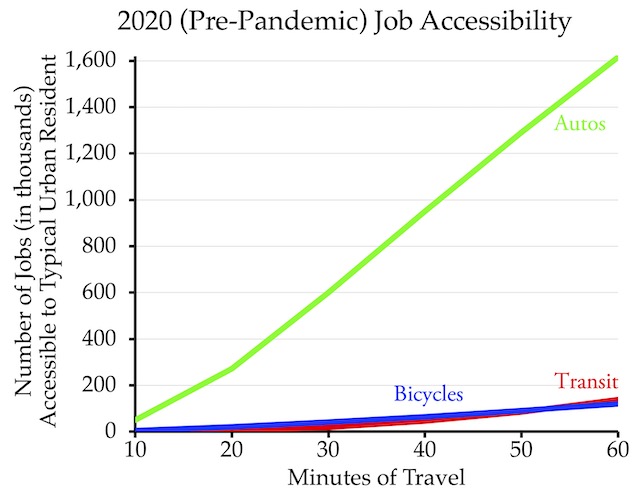The nation’s fifty largest urban areas housed 82.5 million jobs in 2020, and auto drivers could reach 98 percent of them in an hour of travel. Transit riders, by comparison, could reach only 8 percent in an hour while bicycle riders could reach 7 percent, according to the University of Minnesota Accessibility Observatory.
The average resident of one of the nation’s fifty largest urban areas can reach 600,000 jobs in a 30-minute auto trip but only 85,000 jobs in a 50-minute transit trip and 92,000 jobs in a 50-minute bike ride.
I’ve previously cited the observatory’s 2019 data many times, but when writing yesterday’s post about travel speeds and productivity, I noticed that it has recently updated the data to 2020. The introduction says the data were collected before the pandemic so “the 2020 results may provide a useful baseline for evaluating the impact that COVID-19 had on access across America.”
The numbers are only a little different from those for 2019, but the automobile increased its advantage over transit. In 2019, autos could reach 67 times as many jobs in 10 minutes as transit, which increased to 69 times in 2020; autos could reach 11.7 times as many jobs as transit in 60 minutes, which increased slightly to 11.8 times in 2020.
Bicycles also improved slightly compared with transit. A bicycle rider in reasonably good shape can reach more jobs than transit in trips of 30 minutes or less in all 50 urban areas (which was true in 2019); more in trips of 40 minutes in 43 urban areas (compared with 41 in 2019); more in trips of 50 minutes in 31 urban areas (30 in 2019); and more in trips of 60 minutes in 25 urban areas (19 in 2019). The observatory actually provides two estimates for bicycles, one of which assumes bicycle riders refuse to “ride next to fast traffic” and the other assumes riders are “willing to tolerate busy traffic conditions if there is designated space for bicycles.” I used the latter numbers.
The vast majority of the 50 urban areas in this study have been spending lots of money to promote transit and discourage driving. Apparently, they haven’t been spending in the right places or transit’s position would have improved rather than gotten worse.









The future of electric vehicles has fewer than four wheels: According to a new Bloomberg report, global sales of two- and three-wheeled EVs are far outpacing cars and trucks. Half of all vehicles sold with less than four wheels worldwide are electric, compared to 14 percent of cars and 3 percent of trucks and vans.
Because their batteries are fraction of the size. The vehicles cost fraction to obtain/insure.
Urban mobility in European/Asian megacities. Europe has medieval narrow streets and Asia has traffic beyond capacity to alleviate.
Mopeds/scooters and tiny vehicles, average road lane can move 2000 cars per hour,, in urban streets limits and traffic widdle it down to 1000; scooters/two wheel vehicles can move at rate 5-10 thousand, infact narrow accessory lanes can move 2000 an hour, because these vehicles weave thru cars as they stand still